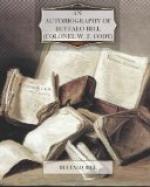As soon as Major North sighted his Pawnees he began riding in a circle, which was the signal to them that there were hostile Indians in front. In an instant they broke ranks pell-mell, with the major at their head, and went after the flying warriors.
The second day that we had been following the Indians we came upon an old squaw who had been left on the prairie to die. Her people had built for her a little shade or lodge, and had given her some provisions—enough to last her trip to the Happy Hunting-Grounds. This is often done by the Indians when an enemy is in pursuit and one of their number becomes too feeble to keep pace with the flight.
Our scout, John Nelson, recognized the squaw as a relative of his Indian wife. From her we learned that the redskins we were pursuing were known as the Pawnee Killer band. They had lately killed Buck’s surveying party, consisting of eight or nine men. This massacre had occurred a few days before on Beaver Creek. We had found a number of surveying instruments in the abandoned camp, and knew therefore that the Indians had had a fight with white men. After driving the Indians across the Platte we returned to Fort McPherson, bringing with us the old squaw, who was sent to the Spotted Tail Agency.
During my absence my wife had given birth to a son. Though he was several weeks old when I returned no name had been given him. I called him Elmo Judson, in honor of Colonel Judson, whose pen name was “Ned Buntline.” But the officers insisted upon calling him Kit Carson Cody and it was finally settled that this should be his name.
Shortly after my return I received orders instructing me to accompany Professor Marsh on a fossil-hunting expedition into the rough lands of the Big Horn Basin. The party was to consist of a number of scientists besides Professor Marsh, together with twenty-five students from Yale, which institution was sending out the expedition.
I was to get together thirty-five saddle-horses for the party. The quartermaster arranged for the transportation, pack mules, etc. But General Sheridan, under whose direction the scientists were proceeding, always believed in my ability to select good horses from a quartermaster’s herd.
In a few days Professor Marsh and his companions arrived. The Pawnee Scouts, then in camp, had a year before unearthed some immense fossil bones, so it was decided that Major North, with a few of these scouts, should also accompany the expedition. Professor Marsh had heard of this discovery, and was eager to find some of the same kind of fossils.
Professor Marsh believed that the Basin would be among the last of the Western lands to be settled. The mountain wall which surrounded it would turn aside pioneers going to Montana or northern Oregon. These would head to the east of Big Horn Mountains, while those bound for Utah, Idaho, and California would go to the south side of the Wind River Mountains. He was confident, however, that some day the Basin would be settled and developed, and that in its fertile valleys would be found the most prosperous people in the world. It was there that my interest in the great possibilities of the West was aroused.




